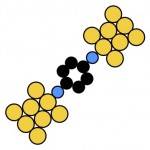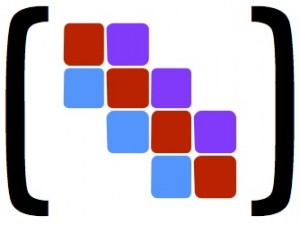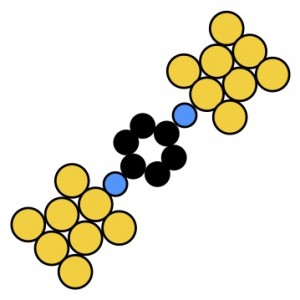Research in the Reuter group sits at the intersection of chemical physics, applied mathematics, and computational science. Some projects investigate the chemical dynamics of nanometer-scale systems, whereas others develop mathematical and computational tools for describing such behavior. Regardless, all projects somehow use physical curiosity to develop new mathematical models and/or mathematical methods to explore novel physical behavior.
Below are descriptions of some recent projects.
- Understanding Electron Transport Processes
- Interpreting Single-Molecule Behavior
- Exploring Matrix Möbius Transformations
- Developing Algorithms for Handling Block Tridiagonal, Block Toeplitz Matrices
- Quantifying Surface Effects in Nanomaterials
Note that several of the projects overlap in various places. Please contact Matt for additional information.
 Understanding Electron Transport Processes
Understanding Electron Transport Processes
Electron transport — the flow of electrons through nanoscale systems — has become an active research topic in recent years due to both its intrinsic challenges and its applications in, e.g., scanning probe microscopies, thermoelectrics, molecular electronics. The quantum mechanical nature of these systems causes several qualitative differences from conventional electronic devices. First and foremost, electrons traverse the nanoscale systems via conduction channels, which relate conductance to transmission probabilities. Second, there are quantum mechanical effects, such as destructive interference features, that lack an analog in conventional electronics.
We perform fundamental research into electron transport processes and attempt to answer questions such as
- Is transport through two neighboring molecules equivalent to twice that through one molecule? If not, why are they different? What chemistry/physics leads to the difference(s)?8,9
- What types of molecules lead to destructive interference features or to other unconventional effects?20
Some of our more computational work on electron transport aims to
- Improve the accuracy of electron transport calculations. Several problems have been reported in transport calculations (for instance, ghost transmission), and we seek to remove these issues.17
- Understand the information content of conductance histograms.12,16,23,24 More information can be found here.
 Interpreting Single-Molecule Experiments
Interpreting Single-Molecule Experiments
Single-molecule experiments are generally complicated by geometrical uncertainty; that is, the experiment is not always able to determine the exact geometry of the system being measured. Consequently, single-molecule experiments are often run many times (sometimes ten thousand or more!) and the data is assessed statistically.
One key example is in the use of conductance histograms to determine the conductance of a single molecule. Many individual conductance measurements are compiled into a histogram, from which the most likely conductance is read. (See this article for a good introduction to the experimental technique.)
We develop models for investigating the statistics of these measurements.12,16,22,23,24 For example, what physical information determines the line shapes of any histogram peaks? We also implement software to extract this information from histograms. See our MolStat package on the Software page.
 Exploring Matrix Möbius Transformations
Exploring Matrix Möbius Transformations
Matrix Möbius transformations are the generalization of the Möbius transformation from complex numbers to matrices. (The book Visual Complex Analysis by T. Needham provides an excellent introduction to complex number Möbius transformations.)
Although we became interested in matrix Möbius transformations through our work in quantifying surface effects in nanomaterials, they are more general tools. For example, other work in conjunction with developing algorithms for handling block tridiagonal, block Toeplitz matrices examines what happens when a matrix Möbius transformation is repeatedly applied to a matrix.21 We aim to further develop the properties and applications of matrix Möbius transformations.
 Developing Algorithms for Handling Block Tridiagonal, Block Toeplitz Matrices
Developing Algorithms for Handling Block Tridiagonal, Block Toeplitz Matrices
Block tridiagonal, block Toeplitz matrices (see the figure for a cartoon of this structure) appear in various applications, notably in
- Finite difference methods with high-order stencils and/or multi-dimensional domains.
- Condensed matter physics, particularly for one-dimensional nanomaterials.
We use matrix Möbius transformations to analytically characterize the inverses of these matrices,21 and also to develop efficient inversion algorithms.14
 Quantifying Surface Effects in Nanomaterials
Quantifying Surface Effects in Nanomaterials
Surface science studies from the 1970s and 1980s found that surface effects persist about 5-10 atomic layers into a conventional, three-dimensional material (e.g., a chunk of gold), regardless of the material, surface cut, surface reconstructions, etc. One-dimensional and two-dimensional nanomaterials (for example, a carbon nanotube or a graphene sheet), however, have demonstrated surface effects that persist quite a bit deeper.
Mathematically, all of these materials possess Hamiltonians with a particular structure — they are block tridiagonal and block Toeplitz in reciprocal space — and we have exploited this structure to examine the role of material dimensionality on the decay of surface effects.5,15 Ultimately, material dimensionality, not material-specific chemistry/physics, is the primary factor controlling the decay of surface effects in the material. Surface effects persist for roughly 25-30 layers in two-dimensional nanomaterials and for many more (50-100) in one-dimensional nanomaterials.